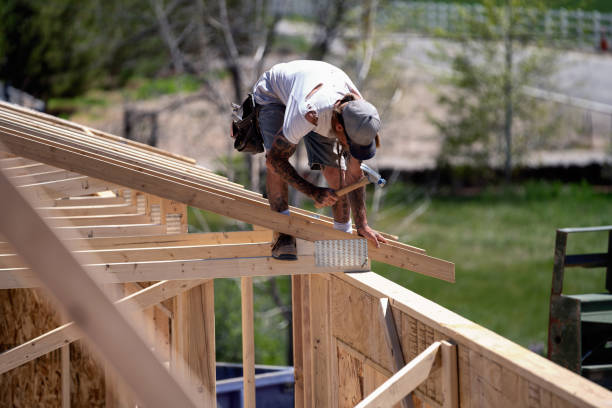Welcome to the article “What Does a Framing Carpenter Do in 2023? Full Guide”. This article will explore the role and responsibilities of a framing carpenter in 2023, including the skills and tools required for the job and the career prospects in the current job market.
As the construction industry continues to grow, the demand for skilled carpenters also increases, and the framing carpenter is one of the essential trades in this field. A framing carpenter is responsible for constructing the structural framework of a building, including walls, floors, and roofs. They work with various materials, such as wood, steel, and concrete, to create a sturdy and safe framework to support the rest of the building.
In this article, we will delve deeper into the day-to-day tasks of a framing carpenter, the necessary skills and qualifications required for the job, and the tools and equipment used regularly. We will also discuss the job outlook for framing carpenters in 2023 and the potential for career advancement and growth within the industry.
Whether you are considering a career as a framing carpenter or simply interested in learning more about this vital trade, this guide will provide you with a comprehensive overview of the role and responsibilities of a framing carpenter in 2023.

Table of contents
- Who is a Framing Carpenter?
- What Does a Framing Carpenter Do?
- What is the average salary of a framing carpenter?
- How physically demanding is the job of a framing carpenter?
- What are the working hours for a framing carpenter?
- What are the most common materials used by framing carpenters?
- What are the primary differences between a framing carpenter and a finish carpenter?
- What are the biggest challenges facing framing carpenters in the construction industry?
- Is being a framing carpenter worth it?
- Frequently Asked Questions
- Conclusion
- References
- Recommendations
Who is a Framing Carpenter?
A framing carpenter is a skilled tradesperson who specializes in constructing the structural framework of a building. This includes the walls, floors, and roof of a structure.
Framing carpenters work with various materials, including wood, steel, and concrete, and are responsible for ensuring that the building is structurally sound and can support the weight of the roof, floors, and walls.
They work from blueprints and plans and use hand and power tools to cut, shape, and join materials. Framing carpenters are a crucial part of the construction industry and play a vital role in constructing new buildings and structures.
You should see this related article: What does an Electric Filter do? (Full explanation with FAQs)
What Does a Framing Carpenter Do?
A framing carpenter is responsible for constructing the structural framework of a building. This includes:
- Reading and interpreting blueprints and plans to determine the layout of the structure.
- Measuring and cutting wood, steel, and other materials to the required dimensions.
- Assembling the structure’s walls, floors, and roof, including installing headers, beams, and joists.
- Erecting scaffolding and other equipment to work at heights.
- Installing windows, doors, and other openings.
- Applying siding, sheathing, and insulation to the structure.
- Checking the accuracy and alignment of the structure to ensure that it is structurally sound and meets building codes and regulations.
- Collaborating with other tradespeople, such as electricians and plumbers, to ensure their work is coordinated with the framing work.
- Maintaining and repairing the framing work as needed.
Framing carpenters complete their work using hand and power tools, such as saws, drills, hammers, nail guns, levels, and squares. They also use equipment such as scaffolding, ladders, and safety harnesses to work at heights. Framing carpenters work in various settings, including new construction sites and remodeling projects.
Check out this article: What Are the Different Types of Executive-Level Jobs in 2023? How to Apply.
What is the average salary of a framing carpenter?
The average salary of a framing carpenter can vary depending on factors such as experience, location, and the specific employer. According to data from the US Bureau of Labor Statistics (BLS), as of May 2021, the median annual wage for carpenters (including framing carpenters) was $49,520.
The lowest 10 percent of carpenters earned less than $31,920, while the highest 10 percent earned more than $91,070. It’s important to note that these figures may vary depending on the specific region, industry, and employer. Additionally, carpenters who have specialized skills or certifications may earn higher salaries.
Read this article: What Does a Chief Cook Do? Full Explanations with FAQs.
How physically demanding is the job of a framing carpenter?
The job of a framing carpenter can be physically demanding. Framing carpenters work with heavy materials, such as lumber and steel, and often work in awkward positions on ladders or tight spaces.
They may also be required to lift and carry heavy objects, climb scaffolding, and work at heights. The work can also involve repetitive motions, such as hammering and sawing, which can be tiring and lead to injuries like carpel tunnel syndrome.
Framing carpenters are also exposed to potential safety hazards such as falling, cuts from sharp tools, and exposure to hazardous chemicals. Therefore, safety measures such as proper protective gear, safety harnesses, and scaffolding are essential in minimizing the risks of injuries.
The job’s physical demands can be challenging, but they can be managed through proper training, safety procedures, and proper use of equipment.
Have you seen this article: What Is ESOL In Education? (Full Explanation With Faqs)
What are the working hours for a framing carpenter?
The typical working hours for a framing carpenter can vary depending on the specific employer, job location, and project stage. In general, framing carpenters work full-time hours, including early mornings, evenings, weekends, and overtime, to meet project deadlines.
During the initial stages of a construction project, framing carpenters may work longer hours to complete the framing work before other trades, such as electricians and plumbers, can begin their work. In some cases, framing carpenters may work 10-12 hour days, 6-7 days per week, to meet the project deadlines.
However, once the framing work is completed, the work schedule may become more regular and closer to a standard 40-hour workweek. Again, it is essential to note that the specific work schedule can vary depending on the employer, location, and stage of the construction project.
Check out this article: What is Intervention in Education (Full Explanation with FAQs)
What are the most common materials used by framing carpenters?
Framing carpenters work with various materials, including wood, steel, and concrete. However, wood is the most common material used by framing carpenters for its availability, cost-effectiveness, and ease of use. The most common types of wood used in framing construction include:
- Softwood lumber, such as pine, spruce, and fir.
- Engineered wood products include plywood, oriented strand board (OSB), and laminated veneer lumber (LVL).
- Treated lumber, which is chemically treated to resist moisture, insects, and decay.
- Steel is also used in framing construction, particularly in commercial and industrial buildings where larger spans and higher load-bearing requirements are necessary. Concrete is another material used in framing applications, such as foundation walls and footings.
The choice of material will depend on factors such as the structure’s size and complexity, the building’s location, and the local building codes and regulations.
Read this article: What Is Seminary School? Why I will prefer Seminary School.
What are the primary differences between a framing carpenter and a finish carpenter?
The primary difference between a framing carpenter and a finished carpenter is the stage of construction in which they work and the type of work they perform.
Framing carpenters work during the early stages of construction, where they build the structural framework of a building or structure. They work with heavy materials such as lumber, steel, and concrete, and they use hand and power tools to cut and shape these materials to fit the building design. They also install framing elements such as walls, floors, ceilings, roof trusses, and structural components such as beams and columns.
Finish carpenters, on the other hand, work during the later stages of construction, where they install the finishing elements of a building or structure. They work with lighter materials such as wood, trim, and molding, and they use hand and power tools to shape and fit these materials into place. They also install decorative elements such as baseboards, crown molding, window and door casings, and functional features such as cabinets, shelving, and staircases.
While both framing and finish carpenters use similar tools and techniques, their work is distinct in terms of the materials and stage of construction in which they work.
You should see this article: What is the Hardest Year of High School? How to Scale Through.
What are the biggest challenges facing framing carpenters in the construction industry?
There are several challenges facing framing carpenters in the construction industry:
Labor shortage
The construction industry needs more skilled workers, including framing carpenters. This shortage can lead to higher labor costs and delays in project timelines.
Cost of materials
The cost of building materials, particularly lumber, has increased significantly in recent years due to supply chain disruptions and high demand. This can make it challenging for framing carpenters to stay within project budgets and can affect project timelines.
Read this article: What is a Quaker School? (Full Explanation with FAQs)
Safety
Framing carpentry involves working with heavy materials and tools, often at heights, which can pose safety hazards. Ensuring proper safety protocols and equipment are in place can help mitigate the risk of injury.
Changing building codes and regulations
Building codes and regulations are constantly evolving, and it can be challenging for framing carpenters to stay current on the latest requirements. Please comply with these regulations to avoid project delays and additional costs.
Environmental concerns
The construction industry is increasingly focused on sustainable and environmentally friendly building practices. Framing carpenters must be aware of these concerns and incorporate eco-friendly materials and methods into their work.
Have you seen this article: What Is ESOL In Education? (Full Explanation With Faqs)
Is being a framing carpenter worth it?
Whether being a framing carpenter is worth it depends on your personal goals, preferences, and circumstances. Here are some factors to consider:
Pros:
- Job security: The demand for framing carpenters is expected to remain steady as new construction projects develop.
- Good pay: Framing carpenters can earn a decent salary, especially with experience and certification.
- Physical work: For those who enjoy physical work and being outdoors, framing carpentry can be a rewarding career choice.
- Career advancement: Framing carpenters can advance to supervisory roles, such as foreman or construction manager, with experience and training.
Cons:
- Physical demands: The job can be physically demanding and may require working in uncomfortable or hazardous conditions.
- Seasonal work: The demand for framing carpenters can fluctuate depending on the season, with more work available during the warmer months.
- Extended hours: The work schedule can be demanding, especially during the initial stages of a construction project.
- Safety risks: Framing carpentry can be hazardous, mainly when working with heavy materials or at heights.
Whether being a framing carpenter is worth it depends on your preferences, goals, and circumstances. If you enjoy physical work, being outdoors, and working with your hands, and are willing to work hard and take on the associated risks, then a career as a framing carpenter could be a good fit for you.
Check out this article: What is Intervention in Education (Full Explanation with FAQs)
Frequently Asked Questions
To become a framing carpenter in 2023, you typically need a high school diploma or equivalent. A vocational or trade school certificate in carpentry is also beneficial. On-the-job training and apprenticeship programs are common paths to becoming a framing carpenter.
A successful framing carpenter needs technical skills, physical talent, and a strong work ethic. Essential skills include reading and interpreting blueprints, knowledge of building codes and safety regulations, proficiency with hand and power tools, and good communication and teamwork skills.
Framing carpenters use various hand and power tools, including hammers, saws, drills, nail guns, levels, squares, and tape measures. They also use equipment such as scaffolding, ladders, and safety harnesses to work at heights.
The job outlook for framing carpenters in 2023 is promising, with a steady demand for skilled carpenters in the construction industry. With a growing need for new construction and remodeling projects, the market for framing carpenters is expected to rise.
Framing carpenters can advance their careers by gaining experience and expertise in specific areas of carpentry, such as stair building or custom cabinetry. They can also become supervisors and project managers or start their carpentry businesses. Continuing education and certification programs can also increase job opportunities and earning potential.
Conclusion
The role of a framing carpenter is critical to the construction industry in 2023. They play a crucial role in the construction of the structural framework of a building, including walls, floors, and roofs. To become a framing carpenter, one must have technical skills, physical talent, and a strong work ethic. It’s also essential to know building codes and safety regulations.
In this article, we have provided a comprehensive guide on the day-to-day tasks of a framing carpenter, the necessary skills and qualifications required for the job, and the tools and equipment used regularly. We have also highlighted the industry’s potential for career advancement and growth and the job outlook for framing carpenters in 2023.
As the construction industry expands, the demand for skilled framing carpenters will continue to increase, making this a promising career path for those who enjoy working with their hands and are looking for a fulfilling career in the trades. We hope this guide has provided valuable insights into the role of a framing carpenter in 2023.
Read this article: What Is Seminary School? Why I will prefer Seminary School.




